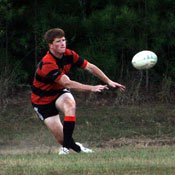As I traveled to the Jackson Rugby Football Club practice on a hot and humid Tuesday afternoon, I had no clue what to expect, but I attempted to visualize how things would go. I reached down and touched the knee brace that protected my surgically repaired left knee as my mind raced. My stomach was filled with butterflies.
We pulled into the grass parking lot as I watched a muscular, ginger-haired man kick a ball over what, in football, would be field-goal posts. I could not help but eye the players on the sidelines to see how big they were as I made my way out on to the field. Watching a sport on TV, you can never tell just how large or tall the players are. It turns out that JRFC has players who range in weight from 150 to 300 pounds and in age from 18 to 57. The club has a family appeal, too, with one father/son pair and one uncle/nephew pair.
The young man kicking the ball turned out to be the JRFC team captain Bill Barrett, who allowed me to take part in the practice.
Doing ball-handling drills, I immediately saw a parallel to soccer and football: The game is as fast paced as soccer and as physical as football—minus the padding. Like soccer, the game was in constant movement with little time to catch my breath.
During the practice, the players introduced me to rugby terms like "ruck"—a gathering of two or more players from opposing teams around the ball usually after a tackle—and "scrum." The interesting thing about a scrum is the etiquette that goes into it. Players form what almost looks like a strange offensive or defensive line. Before the referee places the ball between the players, the players hear a standard cadence: crouch, touch, pause and then engage.
It's a little like everyone knows the snap count before every football play.
As in football, we practiced scrums against a sled, a metal monstrosity that one man stands on while you hit it and try
to drive it backward. I did get to eat dirt in a rucking drill, and my shoulders hurt for days.
Practice wasn't difficult—I had a little background to draw from—but I had not done a lot of running in a long time. My biggest surprise is that my knee held up, only swelling twice its normal size, which is good for me.
I didn't know then that rugby birthed my favorite sport.
The sport of rugby dates back to England in 1823 at Rugby College. Legend has it that while playing soccer, William Webb Ellis, a student and the de facto father of rugby, became so frustrated with his inability to kick a soccer ball that he picked it up and ran with it. While Ellis committed a major breach of soccer etiquette, word began to spread and soon, others wanted to play "soccer" like they played at Rugby College.
By 1843, rugby had spread throughout England, and in 1871 a convention was held to set rules to govern the sport. Rugby came to the United States in 1875, and became the foundation to the most popular sport in the U.S. today: football.
While rugby found a home all over the world—it will be a medal event for the first time in the 2016 Olympic Games in Rio de Janeiro, Brazil—in the U.S., Walter Camp, the "Father of American Football," made some major changes to the game. Camp's contributions included introducing the line of scrimmage and down-and-distance rules.
The Jackson Rugby Football Club started 36 years ago when a group of guys sitting around having adult beverages decided to form a rugby team in Jackson, said Carl Nobles, a longtime member with the JRFC.
In the beginning, the "Old Boys," as they are now known, were chased off soccer fields all over the metro area. Realizing the need for a permanent practice field and a "home field" advantage, the "Old Boys" and new members got together to buy 30 acres in northwest Jackson. Since then, the JRFC has built two fields and a "Social Pavilion."
There are two versions of rugby, seven-man and 15-man rugby. Other than the numbers, the differences are purely strategic. The JRFC plays 15-man rugby. A rugby ball is slightly larger than an American football and is not as elliptical, its ends more rounded. Passing the rugby ball is like a pitch in football and, similar to American football, pitches must be lateral or backwards. In rugby, players are offside if they are in front of the ball. And just like football or soccer, the line of scrimmage and offside is constantly shifting.
Rugby has its social side as well. Nobles told me that the pavilion was for after the games: It is standard for the home team to entertain the visiting team after the game by providing food and beverages.
The JRFC invites anyone to check out its games and, more importantly, to come and learn the sport of rugby. Everyone is welcome at practice. The club has one more game this season, at Memphis Oct. 30. For more information, check out the team's website at http://www.jackson-rugby.com.



Comments
Use the comment form below to begin a discussion about this content.